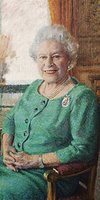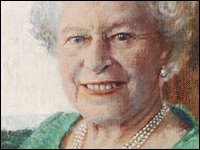 It's a serious business painting the sovereign. And it remains so even when, as in the most recent instance with Rolf Harris's commission, entrusted to a comedian.
It's a serious business painting the sovereign. And it remains so even when, as in the most recent instance with Rolf Harris's commission, entrusted to a comedian.Rolf is one of those Australians probably better known in the UK than in his homeland, in that he has taken it upon himself to represent the Antipodes to the (former) motherland. This he has done through a musical oeuvre that began with "The Wild Colonial Boy" (Rolf Harris Thursday Night at the Down Under Club London [1957]) and notably includes "Tie Me Kangaroo Down Sport" (Relax with Rolf [1960], but much reprised since).
Rolf crosses genres with gusto: he has inducted the Brits into the sound of the digeridoo, and has also spent much screen time demystifying the world of high art, with his mid-composition catchphrase of "Can you see what it is yet?" (One must imagine Michelangelo shouting down the same question from his scaffold while halfway through the Sistine Chapel ceiling.)
And as Rolf's trademark goatee has slowly turned white with age, British television viewers have come to see him less as an over-chirpy annoyance and more as the object of some affection. He is, after all, in many ways our creation, a fixture in the media landscape since time immemorial and for reasons long since forgotten.
The same is, mutatis mutandis, true of Queen Elizabeth II, of course. Like Rolf, the queen is a hangover from a previous age: born into Empire, and still intangibly associated with that curious and much misunderstood international organization, the Commonwealth; her contours gradually softening in old age; for most of us, she has simply always been there, consistently if periodically mentioned in the media, with a glitzy special on the telly at Christmas. So it makes a certain sense that Rolf should be her latest portraitist.
(Hitherto, Rolf's closest brush with the political came with Margaret Thatcher's unexpected and emotional revelation on Desert Island Discs that his version of "Two Little Boys" was her favourite song of all time.)
 Rolf declared that his aim was to represent the queen as "one of us." To put a smile on her lips, and so also on ours. Queenie would be everybody's granny: a little rumpled, a little out of it, sitting in the corner, mostly ignored as the conversation goes on around her.
Rolf declared that his aim was to represent the queen as "one of us." To put a smile on her lips, and so also on ours. Queenie would be everybody's granny: a little rumpled, a little out of it, sitting in the corner, mostly ignored as the conversation goes on around her. Close up, however, Rolf also manages to give the Queen's eyes a maniacal glint. Does this pensioner's harmless façade harbour untold dreams of power?
For Rolf reveals the real predicament of representing royalty: how to give a sense of the monarch's two bodies, the mortal and the juridical. With Rolf's portrait, it is in the eyes, but also the rather awkwardly rendered hands, which reveal not only our artist's struggles with draughtsmanship, but a definite tension, too. The queen is sitting under some kind of duress: she'd rather be with the corgis. But here she is, paraded again for our inspection, the face (and head) of state.
No comments:
Post a Comment